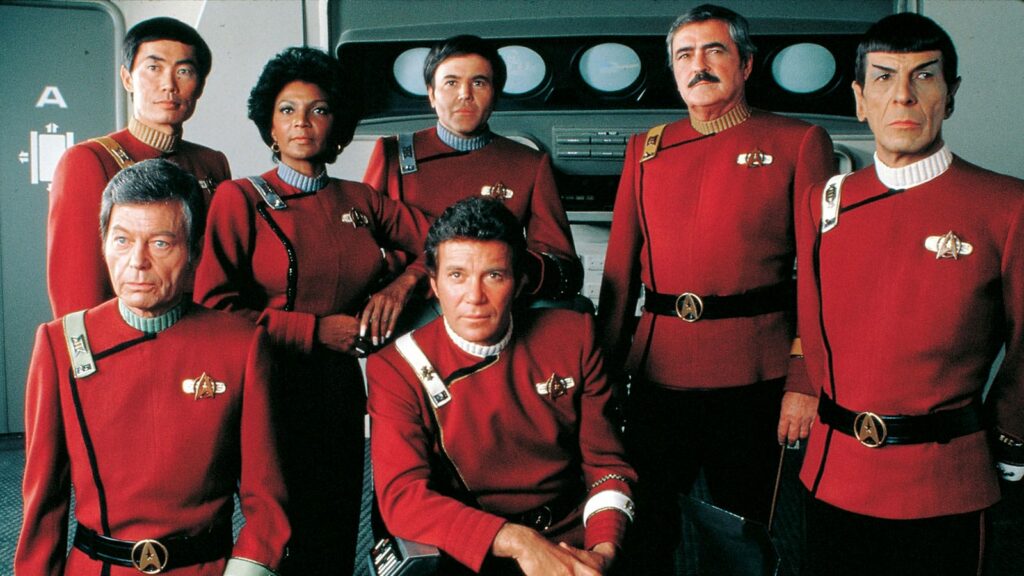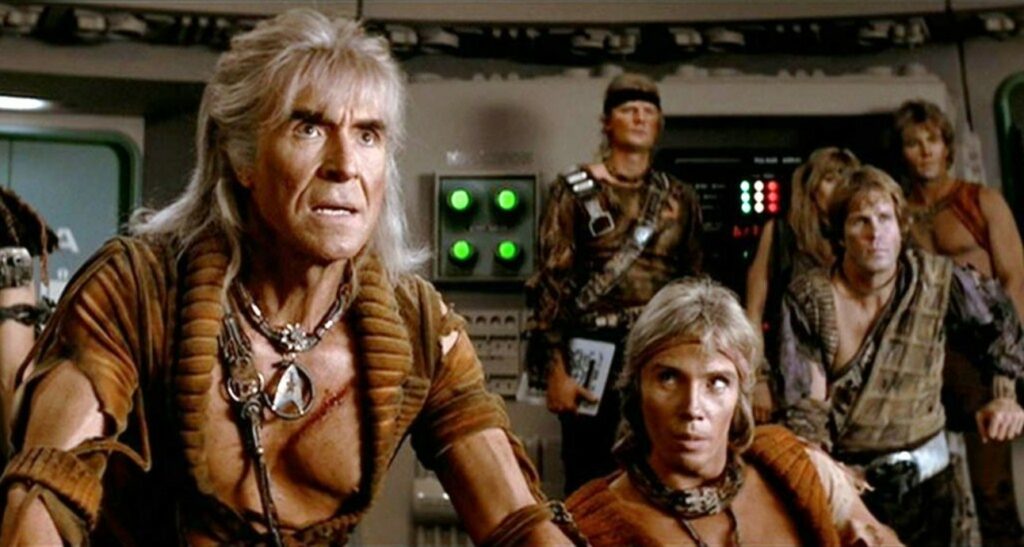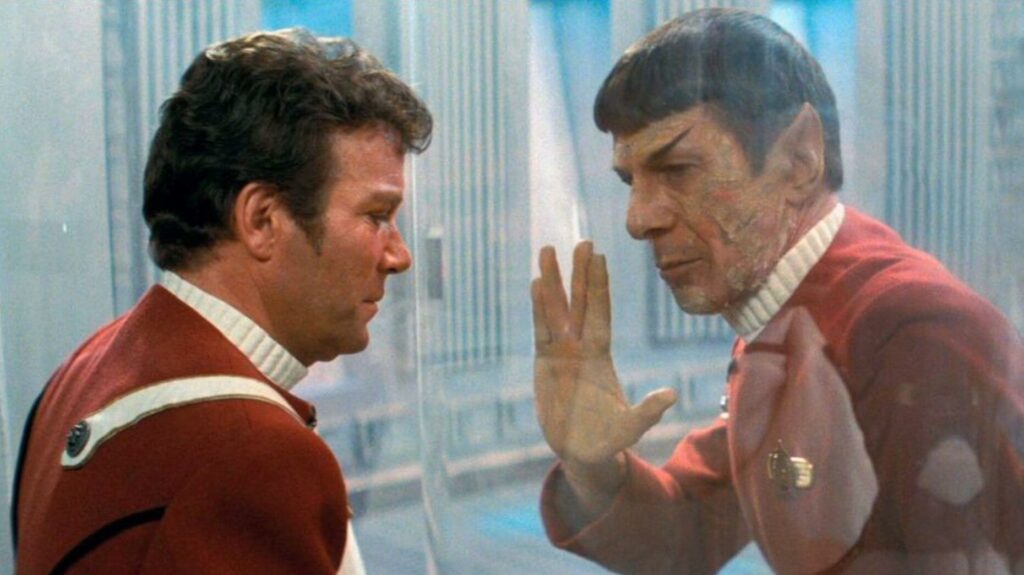The Star Trek franchise and I go way back: as the child of a major Trekkie, I was exposed to star ships, away missions, Klingons, and the Prime Directive from an early age. My dad even liked to brag that I was speaking Klingon at 3. I’ve seen Star Trek II: The Wrath of Khan many times, but its 4K restoration really hit home the extent to which the Star Trek franchise has impacted the world since its genesis in 1966.
For a bit of Star Trek history, The Wrath of Khan was the second feature film to follow the original Star Trek television series that aired from 1966-1969. (We don’t speak of Star Trek: The Motion Picture (1979).) At the time of its original syndication, Star Trek: The Original Series was popular, but it wasn’t until reruns in the early 1970s and the release of Star Trek: The Animated Series (1973-1974) that the cult of Star Trekhit the nerd world at warp speed.
The Wrath of Khan, as some have argued, may not only be the most popular Star Trek film, but it was the one that a) saved the franchise and b) gave life to a wealth of other Star Trek TV series and films from the 1980s to the present. It’s also one of the most quotable Star Trek films, and that’s all thanks to the combination of the charm and wit that the original Star Trek series cast brings to this film.

In all, this film feels like an extended episode of The Original Series. At the centre of this film are questions about Admiral James T. Kirk (William Shatner) getting older and losing the sense of purpose he gained through space adventures. As for the plot, it follows Kirk’s epic clash with an old enemy seeking revenge after escaping from the desolate planet of Seti Alpha V. This enemy is, of course, none other than Khan Noonien Singh (Ricardo Montalbán).
A product of a late 20th-century Eugenics War on Earth, Khan is a genetically enhanced human with superior intellect, strength, and a whole lot of charm. He was introduced in the 1967 episode “Space Seed,” in which his ship, the S.S. Botany Bay, was found lost in space with its crew members suspended in cryogenic sleep. After Khan attempted to take over then-Captain Kirk’s ship, the famous U.S.S. Enterprise, Kirk and his crew left Khan and his defectors on the habitable planet of Seti Alpha V.
Some 15 years later, Khan and what remains of his crew are accidentally found by a former crew member of the Enterprise. Over those years, Seti Alpha V was thrown out of orbit and turned into a deadly desert planet. Khan’s crew, including his wife (a crewmember who defected from the Enterprise), have been all but decimated. Faced with these losses, Khan has grown more angry and vengeful, and, after using desert parasites to take control of the Federation crewmembers who found him, he hijacks a Federation spaceship to find Kirk and enact his long-awaited revenge.

Montalbán’s performance as Khan is nothing short of iconic. His take on a dictatorial, brilliant, highly violent character is balanced with a smooth charm and love of wordplay that make his vengeance highly enjoyable to watch be enacted. His monologues remain reliably sharp in his pursuit of Kirk through intergalactic battles. When first attacking Kirk’s ship –tricking him and the rest of the Enterprise because he is in a stolen Federation ship – he quips, “Ah Kirk, my old friend. Do you know the Klingon proverb that tells us revenge is a dish that is best-served cold?” A dramatic pause. “It is very cold in space.” This moment, and many more, offer the fun mixture of drama and sci-fi schtick that makes Star Trek such a beloved franchise.
Upon returning to Star Trek II: The Wrath of Khan after some years, I was surprised by the heavy focus on Shatner’s character, James T. Kirk, a renowned admiral and Federation hero. Shatner’s cheesy acting style in this franchise has been the butt of many jokes, comedy skits, and parodies for decades, and he’s since proven himself to be pretty egotistical, bashing his old Star Trek co-workers and his fans, as well. While he makes a formidable opponent to Khan through his own brand of intellect, this heavy focus on Shatner retrospectively takes you out of enjoying the film as much as you’d want to.
But what I could not get enough of was seeing the original Star Trek actors and actresses, who have become the TV grandparents for so many Trekkies, thrive together once again. It serves as a crucial reminder of the franchise’s greater impact on the world. We sadly lost the wonderful Nichelle Nichols at age 89 this year, whose long-time performance as Lt. Nyota Uhura was historically significant: when she considered leaving the show, it was Dr Martin Luther King, Jr. who convinced her to stay and continue to represent an intelligent, funny, innovative Black woman in 1960s American television. She has also stood as a role model for people like Mae Jemison, who became an astronaut after watching Star Trek: TOS on TV. While she played a more minor background role in this film, seeing Nichols as Uhura should remind us all of the incredible impact she had on entertainment and representation.
Leonard Nimoy as Mr Spock is, of course, equally legendary and essential to the Star Trek franchise. What I am always impressed by with Nimoy’s interpretation of Spock – whose heritage is part-human, part-Vulcan (Vulcans being a highly logical, anti-emotion alien race) was his infusion of his Jewish identity and culture into presenting the Vulcan people. While the hand gesture for “live long and prosper” is known to gentiles through the context of Star Trek, this gesture stems from one used in a Jewish benediction ritual. That gesture is incredibly important in this film, used to send off Nimoy’s character after he sacrifices himself for the greater good of his crew and friends.

Other actors we have lost, including James Doohan, who plays Lt. James Scott of “beam me up, Scotty!” misquoting fame, and DeForrest Kelley, who plays the irritable but loveable Dr McCoy, were also integral to making this film feel like it was organically forwarding the original themes and ideas of TOS. (We are lucky to have still Shatner, George Takei (Sulu), and Walter Koenig (Chekov) on this earth.)
What I would be remiss to discuss is this film’s restoration. It was sleek. The colours were more vibrant, and the CGI and matte paintings’ special effects even crisper than before. It was a treat to watch this launching point of a film so lovingly restored – and it made this already-exciting film feel eternal, like it would continue to bring wonder to future Trekkies. After viewing this film again, I could only think about Spock’s last words: “You are, and have always been, my friend.”
Star Trek II: The Wrath of Khan was re-released in 4K in select theatres in early September 2022.
